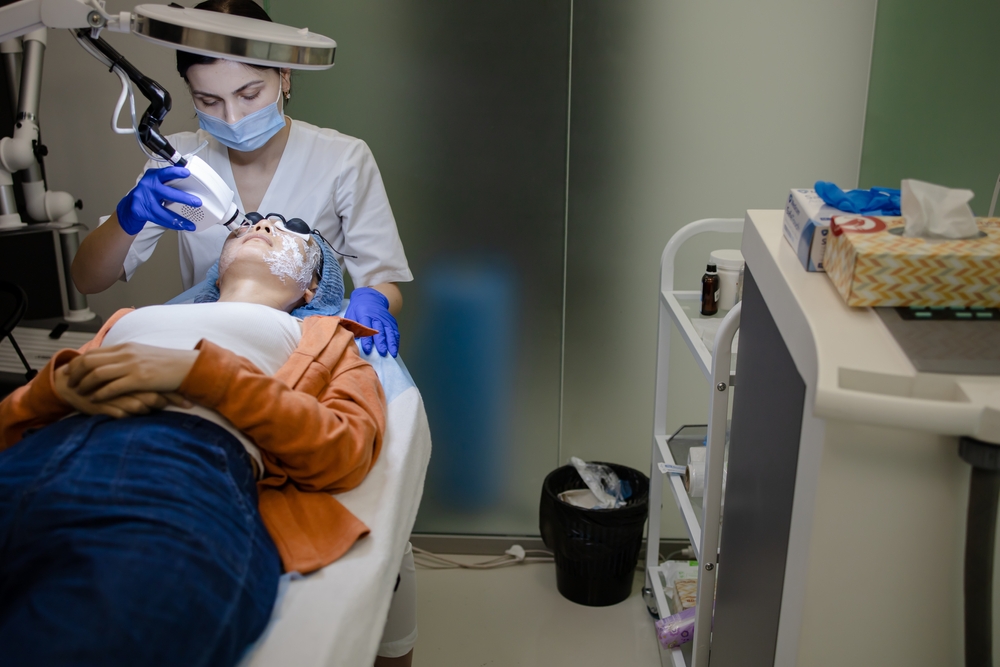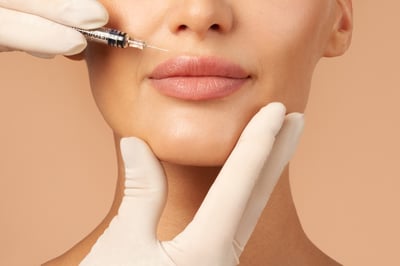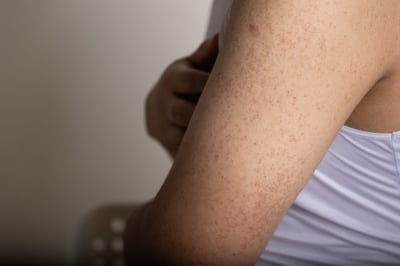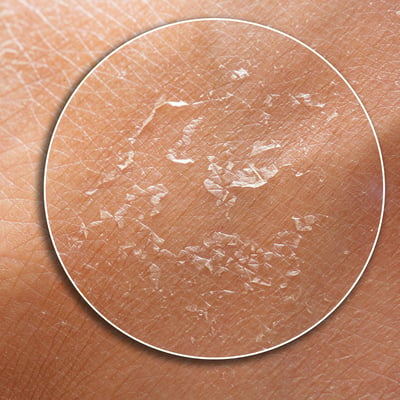
It might be easy to ignore an old acne scar on your back, or that scar you got on your knee from falling off your bike as a kid, but scars on your face are another story. This is especially true if the scar was from something more traumatic, like skin cancer or a car accident.
Luckily, you have options when it comes to removing (or at least reducing the appearance of) facial scars. Here, we’ll look at what options are out there and which options work for each kind of scar.
- Preventative Treatments
- Topical Treatments
- Injectable Scar Treatments
- Skin Resurfacing
- Microneedling
- Cryotherapy
- Surgery
But First: Know the Types of Facial Scars
All scars are tissues made by your body to help cover and heal a wound, but this process can happen in a variety of ways, depending on the particular injury. Different injuries can result in different types of scars, and the different types will respond to various treatments in different ways. So, before deciding on a scar treatment, it’s important to identify which type of scar you have.
- Hypertrophic scars – thick scars that are raised above the surrounding skin due to additional collagen production. They usually appear red or pink and they stay within the original boundaries of the wound. Hypertrophic scars are generally easier to treat than some other types.
- Atrophic scars – scars that appear as a depression or indentation in the skin. They occur from a loss of collagen and can be various shapes and sizes or appear as a wavy pattern. Atrophic scars are common after chicken pox and mole removals and are the most common kind of acne scar.
- Keloid scars – thick, raised scars, similar to hypertrophic scars, but growing beyond the original wound. They can be lumpy and appear red, purple, or brown. Keloid scars can appear months, or even years, after the original wound and may be itchy or uncomfortable.
- Contracture scars – scars caused by extreme damage, like deep wounds, burns, or extensive skin loss. These scars can restrict movement of the surrounding areas and often require surgery to treat.
Preventative Treatments
If you’re concerned about scarring from an upcoming facial surgery or you’re dealing with a current wound, there are some things you can do to lessen the severity of eventual scarring. In fact, treating the wound before the actual scar appears is the best way to avoid scarring or to lessen its severity.
When treating a wound, it is important to keep it clean and moist to lessen scarring. You can apply petroleum jelly to help keep it moist. Once the wound is healed, make sure to apply sunscreen (SPF 30 or higher) regularly. This can help reduce discoloration.
Silicone sheets and gels are often recommended for new scars, particularly after surgery, and have been shown to be very effective. Steroid injections might also be used for preventative purposes after surgery.
Putting pressure on scars during the healing process has also been shown to reduce the severity of the scar. Pressure dressings exist for this, but these may not be very effective for facial scars. Instead, you can massage the scar by applying pressure with your fingers and moving the skin around in different directions. This should be done daily for the first several months for the best results.
Topical Treatments
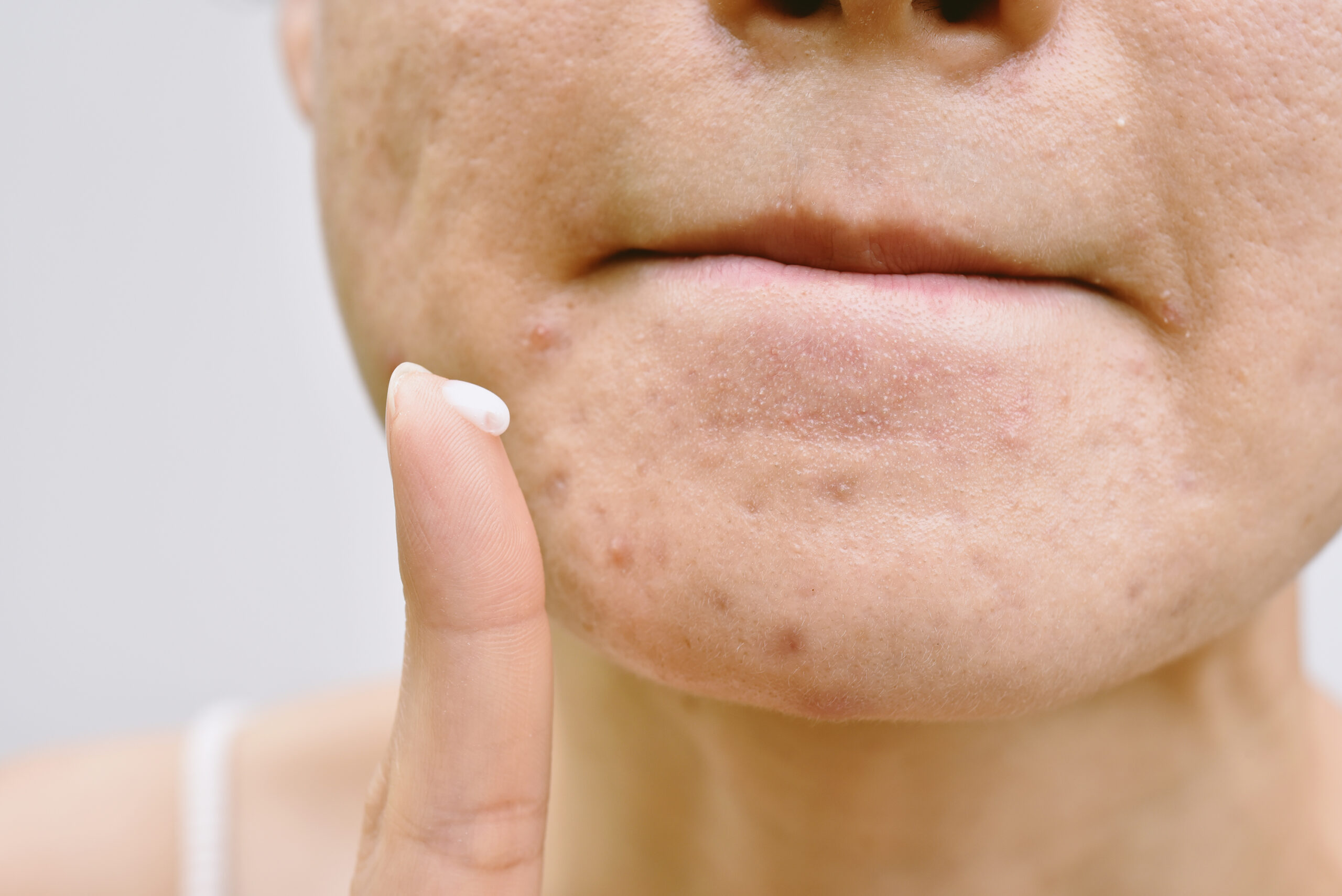
Topical treatments are non-invasive treatments applied directly onto the skin. Many can be purchased over the counter, but those prescribed by a dermatologist maybe stronger or more effective.
Silicone Sheets and Gels
As mentioned above, silicone sheets and gels are often used to lessen scarring during the healing process, but they can sometimes help reduce older scars, as well.These are available over the counter and can work well on smaller hypertrophic and keloid scars. These treatments must be applied every day, usually for months. They will help fade a scar, but might not completely remove it.
Retinoid Creams (for Acne Scars)
Retinoid products are often prescribed by dermatologists for acne scarring. Retinoids are derived from vitamin A and are known for promoting skin renewal and collagen production. Collagen can help fill in depressions left by acne. In one study, 91% of people using retinoids, combined with glycolic acid, experienced significant improvement after 12 weeks.
Steroid Creams
Steroids have been shown to help reduce the appearance of keloid and hypertrophic scars. They are also used to help with itchiness in keloid scars. However, these may not be as effective as steroid injections and won’t help with atrophic or contracture scarring.
Injectable Scar Treatments
These are treatments injected into the scar area by a dermatologist or other doctor. They are often used in combination with other treatments.
Steroid Injections
Steroid injections can help break down extra collagen in keloid or hypertrophic scars, making them flatter. They will also help to reduce any itching or swelling and are commonly used after surgery to reduce facial scarring. However, side effects can include atrophy and skin discoloration.
5-fluorouracil
5-fluorouracil is a chemotherapy drug that also works in treating difficult scars by regulating the production of collagen. It has been shown to flatten hypertrophic and keloid scars, help reduce restrictive movement in contracture scars, and reduce itching and discomfort when injected into the scar. It can also improve the color and texture.
Side effects are rare, but can s include temporary pain, mouth sores, watery eyes, and skin reactions.
Dermal Fillers
You might be familiar with dermal fillers as a cosmetic treatment used to create volume in the face and smooth out wrinkles. However, they are also useful for filling in the depressions of atrophic scars. They can work by temporarily raising the scar area to the level of the normal skin. The downside is that the injections only last around six months to two years and will need to be repeated.
Skin Resurfacing
Skin resurfacing treatments remove the outer layers of skin to reveal healthier skin underneath. Although they are often used for discoloration, wrinkles, and other imperfections, they can also help reduce the appearance of scars. These methods are essentially more extreme versions of at-home exfoliation methods.
Dermabrasion
Dermabrasion is a procedure that uses a device to sand down the top layer of skin with an abrasive material. It is useful on acne scars or other small scars on the face, like skin cancer scars. The procedure itself does carry some risks of scarring, particularly if you have darker skin. Dermabrasion usually results in some minor bleeding and can take around two weeks to fully heal.
Microdermabrasion is a less extreme version of dermabrasion and can help with minor acne scars. Typical downtime is less than 24 hours and possibly only a few hours.
Chemical Peels
Chemical peels use chemicals to exfoliate the skin and remove outer layers. There are many types of chemical peels with varying strengths. Typically, these will only work for less severe scars, including most acne scars.
Laser Resurfacing
Laser and light therapy can resurface the skin with heat, and often help promote healing. There are many types of lasers used for laser resurfacing. For example, CO2 lasers are helpful for treating acne scars and other small scars on the face, like those from skin cancer removal. The Genesis laser can help reduce redness in scars and even out texture in smaller scars, making it good for acne scars.
Microneedling
Microneedling is a procedure where many tiny needles pierce the outer layers of the skin to promote healing and collagen production. It might sound strange, but microneedling can help atrophic scars, like those from acne, by filling in the depressions. Microneedling will leave the skin a little pink or red afterward, but this doesn’t usually last too long.
Cryotherapy
Cryotherapy is a procedure where a dermatologist uses liquid nitrogen to freeze and remove scar tissue. This treatment is good for treating keloid scars and is often combined with steroid injections.
Surgery
Surgery is often used for severe scarring, but there are also some minor surgeries used for smaller scars that don’t respond well to other treatments.
Punch Elevation and Subcision
Scar subcision and punch elevation are acne scar treatments involving minor surgical incisions.
Subcision is a technique for correcting atrophic scars, where a fine needle is inserted into the scar and moved back and forth repeatedly to free the skin from the underlying scar tissue. This raises the tissue to the level of the rest of the skin. The punch elevation method uses a small cookie cutter like tool to cut out the scar. This elevates the base of the scar, making it appear less recessed. Both procedures still leave scars behind, but they are much less noticeable.
Skin graft or flap
In a skin graft or flap surgery, the doctor removes healthy skin from another part of your body and uses it to replace the damaged skin. The transplanted skin forms new blood vessels and attaches to the surrounding tissues. This surgery is often used for burn scars or contracture scars, but might be used after keloid removal.
There is usually significant downtime with these surgeries and there will most likely still be visible scarring in the area, but it will improve movement and the overall appearance.
Tissue Expansion
Tissue expansion is used in combination with skin flap or graft surgery. A balloon-like device is placed under the skin to stretch it out over time, creating more skin to use for a graft or flap.
Z-Plasty
A Z-plasty is a surgical procedure used to improve movement for contracture scars. The surgeon cuts a Z (or sometimes W) shape into the scar to release the tissue and make it more flexible. Z-plasty surgeries are not necessarily for cosmetic improvement, but they might help the surrounding area achieve a more natural shape.
| Treatment | Best for: | Invasive? | Downtime |
|---|---|---|---|
| Silicone Sheets and gels | New scars, hypertrophic scars, keloids | No | None |
| Retinoids | Acne | No | None |
| Steroid Creams | Hypertrophic scars, keloids | No | None |
| Steroid Injections | Hypertrophic scars, keloids | Mildly | None |
| 5-fluorouracil | Hypertrophic scars, keloids | Mildly | None |
| Dermal Fillers | Atrophic scars/acne | Mildly | None or a couple of hours |
| Dermabrasion | Atrophic scars/acne | Yes | Reduced activity and redness for a week or two |
| Chemical Peels | Atrophic scars/acne | Mildly | Depends on type, but generally hours or a couple of days of skin redness |
| Laser Resurfacing | Atrophic scars/acne, hypertrophic scars, keloids | No | Depends on type, ranges from hours to weeks |
| Microneedling | Small hypertrophic scars, atrophic scars/acne | Mildly | None, skin might be red for a couple of hours |
| Cryotherapy | Keloids, hypertrophic scars | Mildly | Reduced activity for a few days |
| Punch elevation/Subcision | Atrophic scars/acne | Yes | None, possible discomfort at the site for a couple of days |
| Skin graft/flap | Contracture scars, large keloids | Yes | Depends on size and location, generally a few weeks |
| Tissue expansion | Contracture scars, large keloids | Yes | Depends on size and location, generally a few weeks |
| Z-plasty/W-plasty | Contracture scars | Yes | Depends on size, generally a couple of weeks |
**Many scars are treated with a combination of different treatments.
Talk to a Board-Certified Dermatologist for the Best Results
The options for scar removal can be overwhelming, but getting a consultation with a Board-Certified Dermatologist is the best way to make sure you choose a treatment that is going to give the best results for your circumstances.
At Forefront, our Board-Certified Dermatologists can determine what kind of scar you have and the best way to approach it. Contact us today to set up a consultation.
